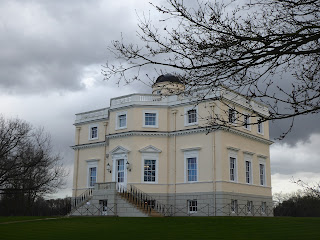Most people who take an interest in history know that King George III was afflicted by a long period of madness that we now understand to have been caused by the disease, porphyria. It's perhaps less well known that he was the first British king to take an interest in science, amassing over his lifetime a very fine collection of scientific instruments and clocks.
In the 1760s, he commissioned the most popular architect of the day, William Chambers, to build him an observatory at Richmond upon Thames, now part of London but at that time, out in the country. Landscaping was provided by Capability Brown.
The building was completed in 1769, in time for the King, the Queen, and two astronomers to observe the Transit of Venus, the passage of Venus across the sun. Occurring only rarely, the transit was thought to provide a method of measuring the distance from the earth to the sun, as well as of determining the size of the universe. Two obelisks were also set up in the park to create a meridian line, and before the Royal Observatory moved to Greenwich in the 19th century, Mean Time was calculated from Richmond.
In the twentieth century, the King's Observatory became the headquarters of the Meteorological Office. It was from there that the weather forecast was taken to decide when to launch the troops into France on D-Day. The two sheds used in forecasting, the only Grade I listed sheds I've ever come across, still stand in the grounds. They were built without nails so that they would be non-magnetic.
 |
| A detail from the Chinese wallpaper in the dining room. William Chambers had visited Canton on two occasions, and a lot of the interior decoration reflects his interest in Chinese art. |
 |
Parts of the stunning collections of Chinese and Georgian porcelain on show
|
The building's fortunes declined after the Met Office's departure, but it has now been restored to its former glory by the current leaseholder, a wealthy and philanthropic businessman, who, like Chambers, has a great interest in Chinese art. The freehold remains the property of the Crown.




This comment has been removed by a blog administrator.
ReplyDelete